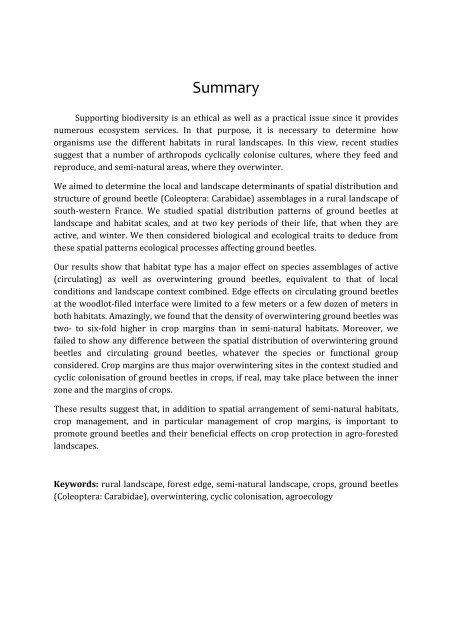Quelle est la contribution des milieux semi-naturels - Les thèses en ...
Quelle est la contribution des milieux semi-naturels - Les thèses en ...
Quelle est la contribution des milieux semi-naturels - Les thèses en ...
Create successful ePaper yourself
Turn your PDF publications into a flip-book with our unique Google optimized e-Paper software.
SummarySupporting biodiversity is an ethical as well as a practical issue since it provi<strong>des</strong>numerous ecosystem services. In that purpose, it is necessary to determine howorganisms use the differ<strong>en</strong>t habitats in rural <strong>la</strong>ndscapes. In this view, rec<strong>en</strong>t studiessugg<strong>est</strong> that a number of arthropods cyclically colonise cultures, where they feed andreproduce, and <strong>semi</strong>‐natural areas, where they overwinter.We aimed to determine the local and <strong>la</strong>ndscape determinants of spatial distribution andstructure of ground beetle (Coleoptera: Carabidae) assemb<strong>la</strong>ges in a rural <strong>la</strong>ndscape ofsouth‐w<strong>est</strong>ern France. We studied spatial distribution patterns of ground beetles at<strong>la</strong>ndscape and habitat scales, and at two key periods of their life, that wh<strong>en</strong> they areactive, and winter. We th<strong>en</strong> considered biological and ecological traits to deduce fromthese spatial patterns ecological processes affecting ground beetles.Our results show that habitat type has a major effect on species assemb<strong>la</strong>ges of active(circu<strong>la</strong>ting) as well as overwintering ground beetles, equival<strong>en</strong>t to that of localconditions and <strong>la</strong>ndscape context combined. Edge effects on circu<strong>la</strong>ting ground beetlesat the woodlot‐filed interface were limited to a few meters or a few doz<strong>en</strong> of meters inboth habitats. Amazingly, we found that the d<strong>en</strong>sity of overwintering ground beetles wastwo‐ to six‐fold higher in crop margins than in <strong>semi</strong>‐natural habitats. Moreover, wefailed to show any differ<strong>en</strong>ce betwe<strong>en</strong> the spatial distribution of overwintering groundbeetles and circu<strong>la</strong>ting ground beetles, whatever the species or functional groupconsidered. Crop margins are thus major overwintering sites in the context studied andcyclic colonisation of ground beetles in crops, if real, may take p<strong>la</strong>ce betwe<strong>en</strong> the innerzone and the margins of crops.These results sugg<strong>est</strong> that, in addition to spatial arrangem<strong>en</strong>t of <strong>semi</strong>‐natural habitats,crop managem<strong>en</strong>t, and in particu<strong>la</strong>r managem<strong>en</strong>t of crop margins, is important topromote ground beetles and their b<strong>en</strong>eficial effects on crop protection in agro‐for<strong>est</strong>ed<strong>la</strong>ndscapes.Keywords: rural <strong>la</strong>ndscape, for<strong>est</strong> edge, <strong>semi</strong>‐natural <strong>la</strong>ndscape, crops, ground beetles(Coleoptera: Carabidae), overwintering, cyclic colonisation, agroecology
















